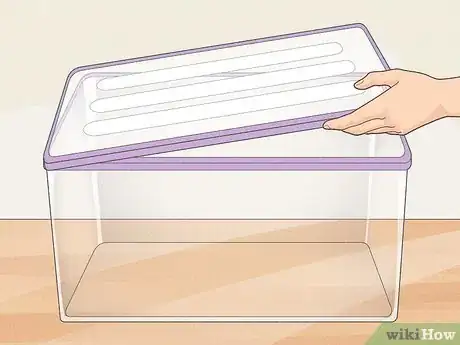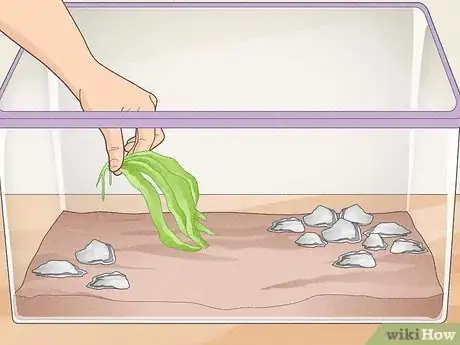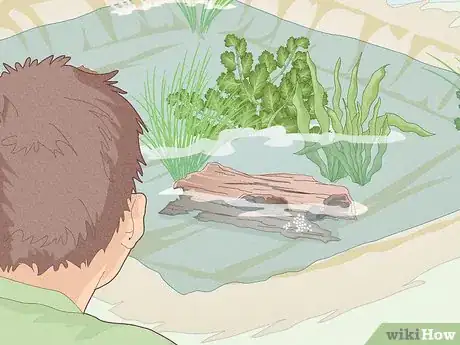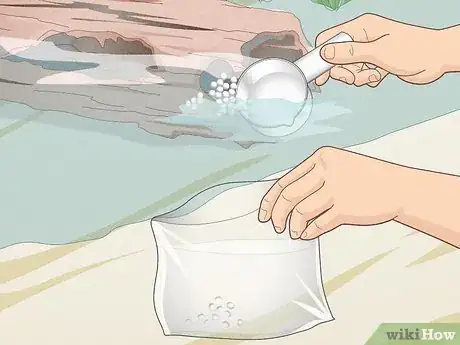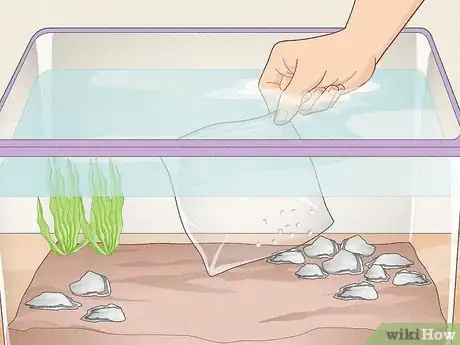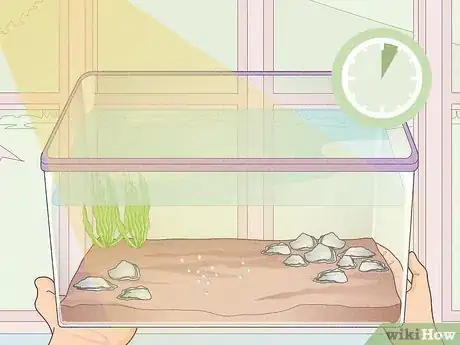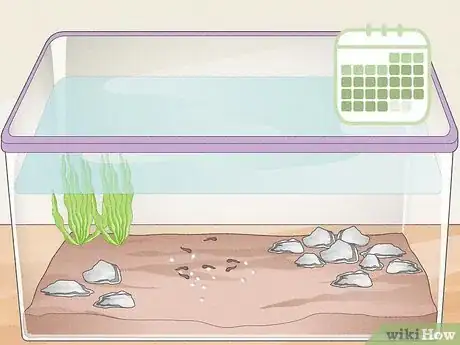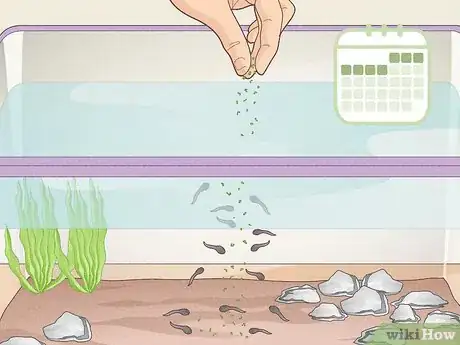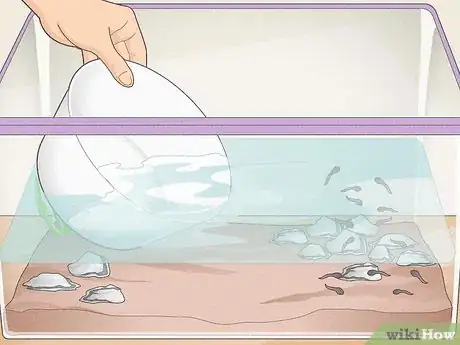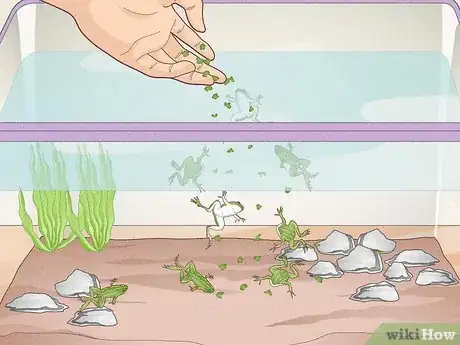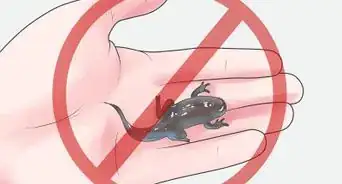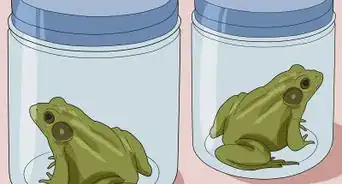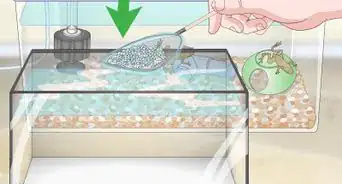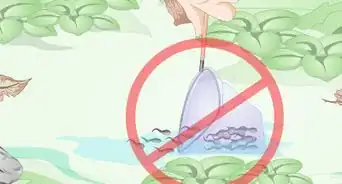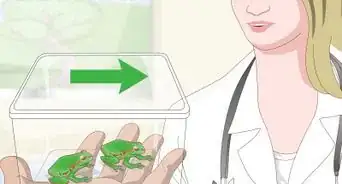This article was co-authored by wikiHow Staff. Our trained team of editors and researchers validate articles for accuracy and comprehensiveness. wikiHow's Content Management Team carefully monitors the work from our editorial staff to ensure that each article is backed by trusted research and meets our high quality standards.
There are 8 references cited in this article, which can be found at the bottom of the page.
This article has been viewed 23,202 times.
Learn more...
Raising frog eggs is an easy and fun experiment for anyone! Whether you want to raise a frog as a pet or help protect a local species, caring for frog eggs is simple. The most important part is setting up the right environment so the eggs grow properly. Once you do that, the eggs take care of themselves until they hatch into tadpoles.
Steps
Tank Setup
-
1Use a clear plastic or glass tank with a lid. A normal fish tank or carrier will work fine for raising the eggs. The important part is that it’s clear so the eggs can get enough light to develop correctly.[1]
-
2Line the bottom of the tank with rocks, dirt, and pond weeds. The best thing to do is gather some rocks or dirt from the same pond that you gather the eggs from. Get a few sticks and weeds too. Line the bottom of the tank with about 1 in (2.5 cm) of material so the tadpoles will have a place to hide when they hatch.[4]
- This material also helps algae and bacteria grow, which tadpoles eat for food.
Advertisement -
3Fill the tank with pond or rain water. You need natural water sources for raising frog eggs. These have the right pH balance and also grow algae that the tadpoles will eat. Either gather some rainwater or fill the tank with water from the pond that you get the eggs from.[5]
- Using tap water to fill the tank might seem like the easiest option, but don’t do this! The pH and chemical contents in tap water aren’t right for frog eggs, and the eggs will probably die.
-
4Keep the tank water at 59–68 °F (15–20 °C). In general, this is the ideal temperature for frog eggs to develop, so keep the temperature within this range. Direct sunlight makes the water way too hot and can kill the eggs, so be sure to store the tank in a shady spot.[6]
- Some guides say to keep the tank outside to copy the eggs’ natural habitat, but as long as the sunlight is right and the temperature is 59–68 °F (15–20 °C), they should be fine inside or outside.
- Temperature consistency is very important along with the exact temperature. If there are big temperature swings, the eggs could die, so keep the temperature stable.
Egg Introduction
-
1Find some frog eggs from a local pond in the late winter. If you have any parks near your home with ponds, these are perfect spots to look for eggs. The eggs look like big clumps of clear jelly with small black dots in the middle. Frogs usually lay eggs between February and March, so this is the best time to look.[7]
- It can be very difficult to tell the difference between frog and salamander eggs, even for experts. Generally, clumps of frog eggs are larger and could contain over 1,000 eggs. Salamander clumps are much smaller and only contain about 30 eggs. Salamander clumps tend to hold their shape outside of the water better than frog clumps.[8]
- There are some websites that sell frog eggs, but experts don’t recommend doing this. These are usually non-native species that could cause problems in the local ecosystem if they escape.[9]
-
2Scoop the eggs and some pond water into a plastic bag. Use a small net or scooper and pick out a small clump of frog eggs. Scoop the eggs into a plastic bag. Then fill the rest of the bag with pond water to keep the eggs fresh until you get home. Seal the bag tightly so it doesn’t spill.[10]
- Remember to only take 3-5 eggs per 1 litre (0.26 US gal) of water in your tank. Scoop some back into the pond if you take too much.
- It’s also a good idea to store the bag in a plastic container to protect it until you get home.
-
3Dip the entire bag into your tank without opening it. The pond temperature and your tank temperature are different, and frog eggs don’t like temperature shocks. Keep the bag closed and gently drop it into the tank. It will probably float a bit near the surface. This gradually brings the eggs to the same temperature as the tank water.
-
4Pour the eggs out after 2-3 hours. Within a few hours, the eggs should be the same temperature as the water. Open up the bag and pour the eggs into the tank water.[11]
- Pour carefully so you don’t spill any of the water or eggs out of the tank. If any water spills out, top off the tank so there is enough water for the eggs.
Proper Egg Care
-
1Move the tank into sunlight for 1 hour each day. While frog eggs don’t like high temperatures, they do need some sunlight to develop. Move the tank into a sunny spot for 1 hour each day, then move it back into its normal shady spot.[12]
- Don’t forget about the tank! If you leave it in the sun all day, the eggs could die.
- Continue doing this after the eggs hatch, because tadpoles need some sunlight to develop too.
-
2Wait 1-4 weeks for the eggs to hatch. Frog eggs usually hatch pretty quickly, but might take up to 4 weeks, depending on when you gathered them. Keep the water temperature consistent and keep moving the tank into sunlight for 1 hour per day until the eggs hatch into tadpoles.[13]
-
3Start feeding the tadpoles about a week after they hatch. Tadpoles don't have to eat for about 24-48 hours after they hatch, and after that they'll start eating the algae that grew in the water.[14] When the algae is gone, they'll get hungry. For food, boil romaine lettuce and cut it into tiny pieces for the tadpoles to eat, or sprinkle some tadpole food pellets into the water. Feed them every 3-4 days to keep them healthy.[15]
- Only feed the tadpoles a little bit at a time. Wait until all the previous food is gone before putting more in for another meal.
- When the tadpoles grow legs, they'll start looking for meat to eat. If you were using lettuce, then either switch to tadpole food or use tiny bits of tender meat like liver for food instead.
-
4Change the tank water once a week. Tadpoles don't need spotless water to survive, but it should be clean. Luckily, changing the water is easy. Use a bucket and scoop out about 3/4 of the water in the tank. Fish out any tadpoles that you picked up and put them back in the tank. Then fill the tank back up with rain or pond water by pouring it in slowly.[16]
- If the water is cold, leave it in your home for a few hours to get the temperature to match the tank temperature.
- Remember to never use tap water to refill the tank. This is toxic to tadpoles.
-
5Care for the tadpoles for about 12 weeks until they become frogs. Continue feeding them regularly and keeping the water clean. Within about 12 weeks, you'll have a froglet, which will become a full-grown frog in a few more weeks.[17]
- The tadpole will first grow back legs, then front legs. You'll notice the tail get smaller and smaller until it's a small stump. The tadpoles' heads will also gradually take the shape of a frog head.
Things You’ll Need
- Clear tank
- Pond water
- Rocks, dirt, and weeds from the pond
- Net or scooper
- Plastic bag
Warnings
- Some areas have laws about taking animals out of their natural habitat. Always check the local laws before gathering any frogs from the wild.[18]⧼thumbs_response⧽
- If you have an outdoor pond with fish in it, raise the eggs and tadpoles inside until they’re full grown frogs before moving them into the pond. The fish will eat the eggs and tadpoles.[19]⧼thumbs_response⧽
References
- ↑ https://www.discoverwildlife.com/how-to/watch-wildlife/how-to-rear-froglets/
- ↑ https://www.discoverwildlife.com/how-to/watch-wildlife/how-to-rear-froglets/
- ↑ https://kb.rspca.org.au/knowledge-base/how-do-i-take-care-of-tadpoles/
- ↑ https://pethelpful.com/reptiles-amphibians/How-And-What-To-Feed-Tadpoles
- ↑ https://pethelpful.com/reptiles-amphibians/How-And-What-To-Feed-Tadpoles
- ↑ https://kb.rspca.org.au/knowledge-base/how-do-i-take-care-of-tadpoles/
- ↑ https://www.discoverwildlife.com/how-to/watch-wildlife/how-to-rear-froglets/
- ↑ https://harriscenter.org/wp-content/uploads/2018/01/VernalPool_EggMassID_2017_HiRes.pdf
- ↑ https://extension.oregonstate.edu/ask-expert/featured/can-i-purchase-frog-eggs
- ↑ https://www.discoverwildlife.com/how-to/watch-wildlife/how-to-rear-froglets/
- ↑ https://www.discoverwildlife.com/how-to/watch-wildlife/how-to-rear-froglets/
- ↑ https://kb.rspca.org.au/knowledge-base/how-do-i-take-care-of-tadpoles/
- ↑ https://www.exploratorium.edu/frogs/mainstory/frogstory5.html
- ↑ https://pethelpful.com/reptiles-amphibians/How-And-What-To-Feed-Tadpoles
- ↑ https://www.farmanddairy.com/top-stories/how-to-raise-frogs-from-tadpoles/609610.html
- ↑ https://www.discoverwildlife.com/how-to/watch-wildlife/how-to-rear-froglets/
- ↑ https://people.wou.edu/~enirei08/frog.html
- ↑ https://kb.rspca.org.au/knowledge-base/how-do-i-take-care-of-tadpoles/
- ↑ https://pethelpful.com/reptiles-amphibians/How-And-What-To-Feed-Tadpoles
